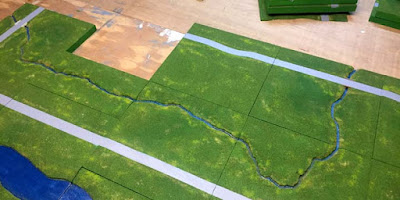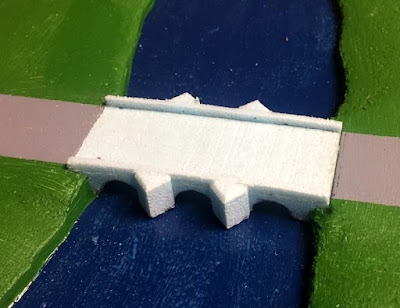I finally completed the first game of World War III, 1958 style. I've been a little under the weather lately, so about three weeks passed between setting it up and actually playing the game.
It was a surprise in a lot of ways. Doing this as a campaign resulted in a much more complex process to generate the battle than I expected; the landscape is bewilderingly devoid of cover, and the units involved ended up being much smaller than I expected that they would be. That was all topped off by rolling up a heavy low cloud deck, affecting sighting and aerial aspects of the battle.
All of that said, the game was a blast; the AAR follows:
_________________________________________
Lt. Page panned the horizon through his binoculars, looking for any sort of movement in the morning gloom. The sky was overcast, and dawn was only just fracturing the darkness, exposing wisps of haze clinging to the landscape. The last couple of days had been turbulent, with preparations for attack suddenly interrupted by movement to the defense. The result was utter chaos.
His recce squadron was spread out on a north south line in the area of Semmenstedt and Timmern, screening for the heavier elements of the 6 Armored Division west and north of his position. Currently his armored car sat in a tree-line between fields immediately east of Timmern, where he watched the roads coming out of Roklum.
He marveled at how peaceful it was, waiting for war to arrive. The only hint of the impending fight were the jets overhead, but even they seemed removed, the landscape insulated by the clouds above.
The gray vehicles on the road startled him, and he did a double take to be sure that his eyes weren't playing tricks on him. They weren't; time to go to work...
World War III begins! The first shots ended up being a small squabble between opposing recconnaissance units. It is early morning with a low overcast and occasional light rain. The British forces were preparing for attack on the next morning, and are generally farther forward than expected in the defense, and in hastily made positions.
British forces consisted of a armored recce squadron of 12th Lancers:
SHQ: 2x Ferret Mk.1, 1x M3 scout car, 2x Jeeps
4x Troop, Lt. Armored Car: 2x Daimler Mk II, 2x Ferret Mk.1
1x Hvy. Troop: 4x AEC Mk.III, 1x Ferret Mk.1
1x Assault Troop: 4x Saracen & Infantry sections
(Note: Ferret Mk.1 proxied with Dingos)
Soviet forces from 10th tank Division:
Divisional Recce Company:
CHQ: 1x BTR-40
1x Pltn: 5x PT-76
2x Pltn: 3x BTR-40
From Motor Rifle Rgmt:
Combat Recce Patrol:
1x T55
1x MR Pltn, 2x BTR-50
Motor Rifle Regiment Vanguard:
MR Company (remainder & attached elements):
CHQ: 1x BTR-50
2x MR Pltn: 2x BTR-50
2x T-55
1x BTR-152A
The game started with the British deployed in and around the two towns, Semmenstedt to the north, and Timmern a little south, sitting patiently, waiting for the Soviet advance.
Soviet BTR-40s advanced down the northern road out of Roklum, with the two platoons hop-scotching along. Slightly behind them was a platoon of PT-76s moving down the southern road, running west out of Roklum.
The BTR-40s got spotted by the Daimlers in the treeline 1400m east of Timmern. They were out of gun range for the Daimlers, so a battery of 155mm guns was called upon to chase the BTRs back to East Germany.
The 155s came in and killed two BTR-40s as their comrades went scrambling for cover. The Pt-76s continued to advance and were spotted as they took cover in the farm between Timmern and Roklum. The eagle-eyed PT-76s took up position at the western edge of the farm, and managed to spot the Ferret in the tree line about 800 meters to the west (rolling an 01 on D100 makes them nearly psychic, low is good), and decided to engage, immobilizing a Ferret Mk.1 (played by a Dingo, as I somehow failed to purchase any Ferret models). The two Daimlers returned fire, hitting nothing, while two batteries of 155mm guns were called in on the PT-76s. The Pt-76s finished off the Ferret and killed a Daimler, and the repositioned BTR-40s called in 152mm guns on the tree line.
Despite anticipating the 155 fire, three of the PT-76s were destroyed while withdrawing from the farm, while the remaining British armored cars in the tree-line made a rush for Timmern. Shortly after the British were backing away, the 152mm rounds started crashing on the tree-line, killing many small rodents.
After a couple of minutes both the remaining Pt-76s and BTR-40s regrouped and continued their advance westward. The British were still in the Semmenstedt, the field south of it, and in Timmern. The remaining BTR-40s "believed" that they had taken fire from the tree-line east of the field, and called in 152mm fire on the tree-line, just east of the AEC Mk. IIIs, which decided to withdraw back into Semmedstedt.
Another Ferret, this one, immediately east of the Semmenstedt, got caught in the 152mm fire, and as the fire walked west, the British SHQ in Semmenstdt ordered everyone to fall back to the next set of positions.
At about this time the CRP from the Soviet Motor Rifle Regiment entered the east end of the table, but the British never saw them.
Losses were:
British: Soviet:
2x Ferret Mk.1 2x BTR-40
1x Daimler Mk. 2 3x PT-76
______________________________________
British recce will take up positions a battlefield or so to the west, and we'll do it again. Somewhere in that area is a Regiment of Centurions and some support, so things will likely get a little more interesting.
The Soviets are currently heading slightly north of west, and taking full advantage of open terrain. Plans are to advance quickly, avoid getting caught up in fights in towns and cities and keep pushing west, fast.
I expect to set up the second game this weekend. and hope to have a new report by late next week.
































































































